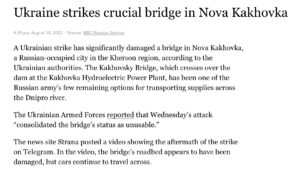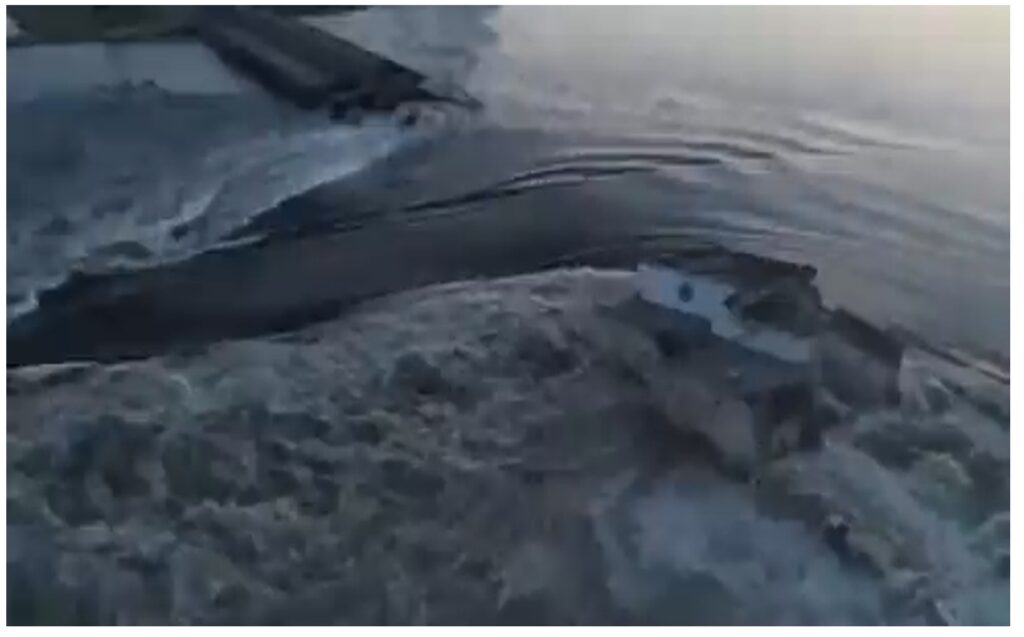SIMPLICIUS THE THINKER
Now that almost a day has passed and the event has settled in, we can draw some conclusions or at least ask some informed questions about the whos and whys, the cui bonos.
The biggest question on everyone’s mind is who was responsible for the Kakhovka dam, and as a corollary, who does it benefit more?
So, to get that out of the way, allow me to list the best points of evidence for each side’s potential involvement, and what they stand to gain:
Ukraine
Firstly, we must mention the preponderance of evidence showing that Ukrainian officials have previously bragged about hitting the Kakhovka dam as well as their plans in destroying it.
Many are sharing this WashPost article, for instance, where the Ukrainian official admitted to striking the dam with HIMARs to test their ability to hit it so they can have that in their pocket as a potential plan to cut off Russian forces:
Titled “Inside the Ukrainian counteroffensive that shocked Putin and reshaped the war”, its journalists quoted former commander of November’s Kherson Counteroffensive Major General Andrey Kovalchuk who shockingly admitted to planning this war crime:
And this article has the videos showing the damage of the Nova Kakhovka dam bridge after Ukrainian HIMARs strikes:

Now, Ukrainian officials and top Telegram channels have been caught deleting their previous posts from last year where they gloated and bragged about having hit the dam repeatedly:

Here they even bragged about penetrating the ‘lock’ of the dam, which I take to mean the actual damming mechanism itself rather than the roadway/bridge adjacent to the dam:

Furthermore, let’s hold to account the Western and Ukrainian ‘experts’ who also were caught previously admitting that Russia would be ‘shooting itself in the foot’ by destroying the dam, and had nothing to gain by it. Here is the infamously offbase Michael Kofman’s take in a Moscow Times interview from November last year:
Next, how can this destruction favor Ukraine?
- The most obvious is it washes away a lot of Russian positions in the Kherson region, particularly given that the flooding affects the left (east) bank more than the right. The most important point on this is that Russia had mined the entire region there to prevent the expected huge Ukrainian landing force attempt. This flooding is now expected to potentially wash away all of Russia’s mines which would give Ukraine a clear path once the water settles down.
- It allows Ukraine, with the help of global media, to get another major psychological victory in the form of international pressure against Russia at the key moment of the kick off of their offensive. They can attempt to use this international pressure against Russia as a compounding force with other upcoming falseflags and psyops which will reach a critical peak as they accelerate into the hot portion of their offensive activities.
- If this ends up truly affecting the ZNPP nuclear plant (though for now the concensus appears to be that ZNPP is all right), then it will allow them to string it into a larger falseflag later on, depending what type of damage ZNPP could potentially take.
- Likewise, if it ends up being detrimental to the Crimean canal, once more imperiling the Crimean water supply, this could add an additional pressure on the Russian government.
- There are some theories that eventually, after the water levels out, it could benefit Ukraine in allowing them to cross the Dnieper with the planned amphibious assaults, as Russia would no longer have a tump card of unleashing the dam (whether by opening sluice gates or blowing it) to wash away their landing forces.
- Considering that the dam was a hydro-electric plant, and Russia was the beneficiary of the generated electricity, that means the loss of this electricity generation coupled wth the loss of the generation from the ZNPP—which was said to have been forced to power down due to escalations—could be a big net liability for the Russian controlled territory in that region, and could give Russia potential difficulties in supplying adequate power to the region, further souring the population against Moscow.
Russia
Firstly, the question of what evidence might there be that Russia was behind the destruction of the dam?
- Recall, that Russia was said to have controlled the dam. On one hand this gives them an easier ability to ‘destroy it’ in the cleanest way possible if they should want to do so.
BUT:
- The biggest evidence against this is the fact that Russia, having controlled the dam, could simply have lifted the floodgates at any point, if they wanted to effect a huge flood down stream and release of the reservoir. This is the same famous argument used in the Nordstream case. If Russia wanted to turn off the Nordstream to Europe why would they destroy it if they can simply turn it off at their end?
- The Ukrainian claim/position is that Russia destroyed the dam in order to flood the river and stop a potential Ukrainian river crossing. So why would Russia need to destroy it, as per the above, if they can flood the river all the same just by opening the dam’s floodgates? It makes no logical sense.
- The only piece of evidence that Russia could feasibly do it is that this famous strike from last November is claimed to have been Russian forces blowing up the passenger/car bridge next to the dam after they had retreated from the Kherson region, so that Ukraine would not be able to cross the dam with tanks, etc.
The truth is, no one knows who was responsible for this blast definitively. But, it is plausible that it was Russia simply because this was at the time they had withdrawn from Kherson and had also just blown the Kherson bridge in early November. This one was blown, it seems, the very next day. As I understand it, the above video is from November 12, 2022, and the Antonovsky bridge in Kherson was blown on November 11. However, for the record, some on the pro-Russian side state that this was infact a HIMARs strike.
So this makes it very plausible that Russia blew both bridges. However, does that mean Russia blew the dam? No. But it’s the only scant evidence merely suggesting that if Russia was capable of blowing the bridge next to the dam, maybe they’d hit the dam too.
The fact is, if the above is true then both Russia and Ukraine have proven claims of hitting the bridge. However, Ukraine hit it many more times and on top of which, they had planned to send naval mines into it to destroy the actual dam itself, as per intelligence from last year.
What’s strange is we do have surveillance footage of the bridge blowing from when Russia allegedly blew it up after retreating. However, now Russia says Ukraine blew it yet they have released no surveillance footage to back up the claim.
Also, this Tass article which quotes Shoigu in his accusations of Kiev for the attack, uses the word “undermining” of the dam. Some are taking this to mean literally that Russia’s position is Ukraine “mined” the dam, as in naval divers planting explosives.
However, other officials on Russia’s side released statements claiming that a Ukrainian Alder-M MLRS, adapted from Russian BM-30 Smerch, was used to destroy the dam. Either way, surely the dam had surveillance cameras just like last time, no? So, if that’s the case, why hasn’t Russia released footage of what would be obvious MLRS strikes? This appears to be a point that goes against the Russian side.
Now, how might the dam destruction benefit Russia?
- Conversely to what was said before about Russian positions being swept away, it can be said that Ukrainian positions inside those islands in the Dnieper river near Kherson will be washed away.You see, Russia was having a hell of a time with recalcitrant AFU constantly entrenching themselves on these marshy islands between Kherson and Russia’s side of the Dnieper:
This flooding conveniently allows Russia to wash away all their forward positions, entrenchments there, etc.
One of the key things Ukraine was doing in these islands is setting up drone repeaters and relays. These are small antennas that allowed their drones to double and triple their range, so they can be flown from Kherson all the way to Russia’s positions 5-10km by amplifying the signal of the controllers.
Here’s one of the most compelling arguments I’ve seen for why the situation greatly benefits Russia:
If Russia wants to cross the Dniper and liberate places like Odessa, this Dam needed to be blown up. Surovikin understood this immediately, that he cant advance with this dam in his back that can cut his forces from supply for weeks if blown up. So he left the west bank of Kherson when the water was not high yet.
The spring rains filled it up.
But for Russian troops to re-cross and move towards the Russian city of Odessa, to liberate the east and connect with the Russian troops isolated in Transnistria, the dam needed to go…
Also now when it is blown up, it has some other bennefits. It floods all the ammunitions’ depots the Ukrainians had been building up. All their work over the past few months is going to be underwater now. Like bees they had been preparing for their sabotage groups to move forward and now… this floods their advance bases from which they intended to lunch and support commando groups to attack Russia in the ‘back’ in support of their offensive.
The water also makes now a protective barrier for a few weeks at least on the Russian west side so Russia can concentrate on the North, where the ukrainian main counteroffensive is traying to develop. Now the Russian flank is protected. Other wise Russia would need to keep allot more troops in here, to counter the Ukrainian raids, keeping men tied up b/c if they let them trough those groups will move between the army in the north and Crimea.
Finally blowing it now, allows the blame to be laid at Ukraine door, as something they did for their counter-offensive. So it is a good time to do it because the flooded population will blame Ukraine.
Either side could have done it, but there are reasons why the Russian military intelligence carried this operation. It can not be excluded. Things look bad now, but imagine in a few months when the Ukrainian counter offensive is destroyed, their reserves chewed up. Vagner is back pushing forward in Donbass as do other Russian units. The Ukrainians are hard pressed and then all of a sudden Russian airborne and marines land in Kershon, back again! The Ukrainians have few reserves to meet them with, their main Ukrainian army is hard pressed in Donbass and they cant blow up the Dam.…
This is a very convincing argument and I do agree with it. With that said, I’m not certain how feasible it would ever be for Russia to cross the Dnieper, dam or not. I had always operated under the assumption that militarily it would mostly be impossible for anything other than some light amphibious forces to do harassing or sabotage attacks. But for an entire army group with several corps crossing the river seems very dubious. But, if it is possible, then this certainly would be the method, and you would definitely have to take care of the dam first to make sure it’s not a monkey on your back at all times threatening to disconnect your forces from their logistics/supply.
Recall that we’ve seen many new ‘firsts’ recently to the extent that Russia had begun to finally cash in its promises for crossing various red lines. They’ve begun to hit some bridges, they hit some leadership centers like the GUR building (Budanov, where are you?), could blowing the dam be another new escalatory action?
On one hand, it does not seem Putin’s style at all, because it harms far too many civilians and goes against the entire creed of the SMO—which was the preservation of civilians at all costs and a war only against the regime forces. But, if Putin has in fact finally turned over the SMO to hardened generals and commanders like Suvorikin in the past who know difficult decisions must be made to win a war, then anything is possible.
Particularly because we don’t know what intelligence Russia has insofar as Ukrainian plans for doing an amphibious assault across the river. For all we know, Russian MOD got intelligence recently that the final huge assault to seize the nuclear plant was about to go down, and they effected a decisive action to stop it.
Here’s another thought-provoking take on who gains:
️
️
️ Resident UA channel
Our source in the OP said that at the headquarters they discussed the formats of the counteroffensive after the explosion
Kakhovskaya HPP, which changes the plans of the Armed Forces of Ukraine. While everyone is discussing the situation below the dam and the flooding of the Kherson region, the real problem arises around the operation to storm the ZNPP. The Kakovskoye reservoir is rapidly shrinking, which means that it will be extremely difficult to carry out a landing operation. There will be shallow water for several kilometers, which will not allow the use of boats, and our paratroopers will have to move on wet sand, turning into convenient targets for the enemy.
In short, this claims that Ukrainian command is now miffed because this greatly complicates or outright negates their plans to seize the ZNPP, which would of course be in Russia’s favor.
The ‘Natural’ Theory
The evidence for the natural theory, which is that the dam collapsed on its own, is as follows.
Firstly, satellite photos were released showing that the dam had already been massively leaking at the center in the days leading up to the breach:
If you’ll note the road bridge above the leak is even said to have collapsed, though it’s uncertain whether that’s the portion which “Russia” blew up previously, which I talked about before.
In this video, you can see June 4 and the leak, with June 6 and the breach juxtaposed, which appears to be right where the center leak was:
The question is, has anyone confirmed that this, what I’m calling, “leak” was in fact a “leak” due to natural damage? I haven’t seen such a confirmation yet but this is what most are assuming thus far.
Here’s a report:
News from the Kakhovskaya HPP, meanwhile, is disappointing.
First, satellite imagery emerged showing that the dam began to fail a few days ago when the spillway flow near the so-called S-shaped bridge increased dramatically and the bridge itself eventually collapsed on June 1-2 (1). It was in this place that the Ukrainian military methodically hammered last year, trying to disrupt the operation of our crossing. Now here is the biggest gap (2).
Secondly, and this is the most unpleasant, the section of the dam between the power plant building and the lock (3) was washed away. Here the dam is made of sand, which means that it is likely that it will be washed away to the ground, to the full depth, and the reservoir will be completely drained. To put it simply, it is here that the new channel of the Dnieper can eventually go.
From the good news: at the time of the satellite imagery, the gates of the water conduits of the hydroturbines (4) were still holding. But if the sandy part of the dam is washed away, this is a consolation from the series “the patient sweated before his death.”
This video appears to be from only moments after the actual full breach, and it can perhaps give clues as to whether some type of explosive was used, or whether it deteriorated naturally:
What you’ll note in this video is the center portion is breached, but the part on the right side has not crumbled yet. Later, an entire separate water breach appeared to have formed on the right bank, as seen here:
Many have noted that the breach in the center would be exactly where water pressure would be highest, which points to a natural cause. However, if you were to plant explosives, you’d likely do it in the center too, would you not? Why plant them at the edges? Well, ideally you’d probably want to plant them everywhere, depending what effect you were trying to achieve. Perhaps you’d be inclined to make it look like a natural cause.
Also, there are no marks from MLRS strikes that can be seen. If some Smerch-like MLRS system was used (massive 300mm rockets that are extremely powerful, much more so than 227mm HIMARs), you’d think that the rockets would have a dispersion field where they would strike other parts of the dam that could be visible from some of these views as craters in the ground. But it looks like a clean break.
There is the strange point about the explosions that were seen for a long time after the breach. Recall, yesterday I posted two videos of what appeared to be mortar strikes happening all around the destroyed dam. I had hypothesized these were the naval mines sent to destroy the dam.
However, after seeing two new such videos, my new theory which is far more likely is that these are Russian beach mines which were washed away by the rushing waters and were exploding all over the dam as they hit any obstruction. It was already confirmed weeks ago that Russia was heavily mining the coast, particularly around Energodar ZNPP plant, to stop Ukrainian amphibious assaults to seize the plant. I had even reported on this already a few reports back. This is the most natural explanation to me: the mines were washed away from the shore/beaches and continued to explode long after.
Here are two new videos of them:
The guy in the video thinks it was an aerial bombing but I don’t think so.
Just to have them all in one place I’ll repost yesterday’s explosions as well, and will state again that they don’t have a characteristic tell-tale whistling noise like mortars or artillery, nor do you visually see anything arrive:
The other big elephant in the room that those on the Ukrainian side are conveniently ignoring and which sort of fits under the ‘natural’ but unnatural category is the known fact that for a month or two now, Ukraine had begun filling up the Kakhovka reservoir, putting immense pressure on the dam.
You see, Ukraine controls several other dams upriver, and by playing with their water levels, they can pass more or less water down river to the Kakhovka dam. I had posted this very tweet and corresponding video a month ago in a report:
Note the date: May 4th of this year. Videos began to show that the Kakhovka reservoir was dangerously rising at that time. And several scientific charts prove it:
And what’s interesting, the above Tweeter Zoka even predicted it on May 4th:
As you can see, he states that Russia was unable to open the dam to relieve the pressure due to the dam locks having suffered previous damage from Ukrainian strikes. So Zoka predicted a month ago the dam would soon collapse.
However, two days later he posted a video showing that Russia managed to figure out a way to open at least some of the sluice gates. I haven’t verified how true that is, but there’s a chance that perhaps they weren’t able to open them this time, or only opening a few and not all of them was not enough to negate the pressure building from the upriver games Ukraine was playing.
And by the way, today there were reports that Ukraine again dumped water downstream to, apparently, exacerbate the flooding as it was reported they opened up reservoir gates at their dams upriver, though I haven’t seen specific evidence other than the reports.
And also, Shoigu in his report today stated the following, confirming that Ukraine was raising water levels from the Dnipropetrovsk hydro-electric plant upstream:
According to the available information, the amount of water discharged from the Dnipropetrovsk HPP has been noticeably increased, which leads to additional flooding of the territories. This fact indicates that the Kyiv regime planned a large-scale sabotage in advance.
However, Shoigu’s angle appears to be that Ukraine opened the floodgates upstream to vastly increase the amount of water but then still destroyed the Kakhovka plant via sabotage. The upstream increase was simply to make the effects of the destruction far more severe, as there would be much more flooding.
And what’s further interesting, is that Shoigu’s position for the reason Ukraine did this is because they actually want to transfer their Kherson troops to the main offensive directions, i.e. Zaporozhye, Donetsk, etc. The way I’m understanding it is, following this logic, the AFU feared moving the Kherson troops as Russia would have a force overmatch in that region, and presumably they somehow feared Russia can enact landing operations to seize Kherson again if Ukraine removed all their troops from that region. So by flooding the region, the logic would appear to be that this would allow Kiev to safely remove the troops without fearing Russians being able to cross the river.
Undermining the structures was part of Kyiv’s plan to transfer units and equipment from the Kherson direction to the area of offensive operations – the enemy is preparing to go on the defensive on the right bank of the Dnieper.
And the reason I called this the ‘natural but unnatural’ method was because this would mean the dam collapsed on its own rather than direct fire or explosives sabotage, but it was still pushed into collapsing by direct action from the Kiev regime. Did the AFU know that the dam was in bad shape and could collapse with more water pressure and so began to build this pressure up in order to collapse it just in time to coincide with their spring/summer campaign?
To be honest, given the evidence above, it does seem to me the much more likely culprit was this ‘semi-natural’ method, but the blame would still fall on Ukraine for having facilitated it by pumping up the Kakhovka reservoir from upstream. So, if you asked me to name my most likely culprit from the three choices above, I’d likely go with this one. But Russia appears to be doubling down on their accusations of Ukraine, as not only did Shoigu release the statement accusing Ukraine of being responsible but Russia’s ambassador to the UN, Vasily Nebenzya even pressed the UN to condemn Ukraine for the ‘terror action’:
️
Kiev regime openly flaunts terrorist tactics and is responsible for explosion on Crimean Bridge, murders of Daria Dugina, Vladlen Tatarsky, not a WORD of condemnation from West has been heard – Top Russian diplomat at UN Nebenzya.
UPDATE: West is accustomed to using someone else’s hands to do their dirty work – Nebenzya.
And Russia’s Ministry of Foreign Affairs’ official statement:
Other analysts like Colonel McGregor said he suspects the British SAS to have been involved, which many agreed with simply owing to the fact that it’s much more difficult and sophisticated of an operation to blow a dam than is commonly thought.
Also, here’s the official utility company’s prognosis:
The peak of spillage of water from the Kakhov reservoir is expected in the morning of June 7, – Ukrhydroenergo
“Furthermore, the water level will stabilize . In 4-5 days, the water will begin to fall,” said the head of Ukrhydroenergo.
And this concerning forecast:
The destruction of the Kakhovka hydroelectric power plant will lead to the fact that the fields in southern Ukraine could turn into deserts next year.
The Ministry of Agricultural Policy of Ukraine reports this on its website.
According to them, the Kakhovskaya HPP disaster effectively left 94% of the irrigation systems in Kherson, 74% in Zaporozhye, and 30% in the Dnepropetrovsk regions without a water source.
The destruction of the Kakhovskaya HPP will also have negative consequences for the fishing industry: fish deaths have already been recorded.
They themselves create a catastrophe and resolve the consequences. Everything according to script…
And note how nonsensical Ukraine’s explanations are. A Ukrainian officer in this CNN article literally said in the same breath that Russia blew up the dam, yet also gloated how many Russian troops were washed away (implying they were killed) by the flood and that it destroyed many Russian troop positions. Does he not see the illogicality of that statement? So Russia blew up its own dam without informing its troops and got them all killed? It’s worthy of a facepalm.
And this tweeter makes a good point:
That mostly covers the dam situation. The only things to add are some media of the consequences. Note that the Russian side of the river suffered the worst of it, particularly the town of Kakhovka, which as I said before, was known all along, as the unique geography there simply makes Russia’s side more vulnerable to the flooding. Which, again, is a point against the theory that Russia did it:
How Russian servicemen are dealing with the flooding in their positions:
I’ll keep this one short, other than to say that Russia retook Novodonetsk today near Velyka Novosilka, nor did Ukraine ever even fully hold it apart from part of the settlement. So that means yesterday’s offensive and all its attendant losses were completely fruitless for the Kiev regime as they were pushed back to their starting line. But I’ll have more updates on that next time.
Let’s see what tomorrow brings.



















